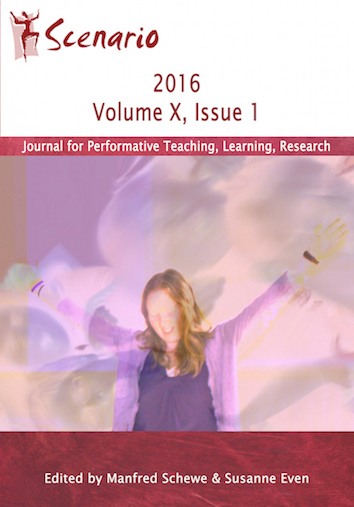Performative Script analysis for additional language classrooms
DOI:
https://doi.org/10.33178/scenario.10.1.4Abstract
This paper discusses a variation of theatrical rehearsal practice that I adapted for a university level English for Academic Purposes (EAP) English course on which I taught and is also based, in part, on a workshop presentation I gave at the 2013 WATESOL conference in Wellington, New Zealand. The activity and its procedures, which are described in this paper, originated in my experiences and training as an undergraduate in theatre studies and also draws from my subsequent career in the performing arts. While the practice of script analysis is definitely not a new invention, being, as it is, one of the most fundamental activities that modern actors undertake in preparing for rehearsal, I feel this particular procedural variation of the practice is novel for second or additional (L2) language classrooms. I had wanted to experiment with scripted performance in my classrooms for some time, so I designed this activity to be feasible for students without any experience with the performing arts.This paper is arranged as follows: Firstly, I provide a brief background and rationale for the activity. Next, I explain in detail the procedures of the task. Lastly, I will briefly discuss students’ post-task feedback collected from an exploratory study ...Riferimenti bibliografici
Baines, Richard & O’Brien, Mike (2006): Navigating Senior Drama. Cambridge: Cambridge University Press
Belliveau, George & Kim, Won (2013): Drama in L2 Learning: A research synthesis. In: Scenario 2, 6-26
Brockett, Oscar G. & Hildy, Franklin J. (2008): History of the Theatre, 10th Edition. Harlow: Pearson Education Limited
Crookall, David (1984): The use of non-ELT simulations. In: English Language Teaching Journal 38/4, 262-273
Di Pietro, Robert (1987): Strategic Interactions: Learning Languages Through Scenarios. Cambridge: Cambridge University Press
Donnery, Eucharia (2009): Testing the Waters: Drama in the Japanese University EFL Classroom. In: Scenario 1, 17-35
Hornbrook, David (ed.) (1998): On the Subject of Drama. London: Routledge
Jones, Ken (1982): Simulations in Language Teaching. Cambridge: Cambridge University Press
Kao, Shin-Mei, & O’Neill, Cecily (1998): Words in Worlds: learning a second language through process drama. Stamford, CT: Ablex Publishing Corporation
Kitson, Neil & Spiby, Ian (1995): Primary Drama Handbook. London: The Questions Publishing Company
Mackey, Sally & Cooper, Simon (2000): Drama and Theatre Studies. Cheltenham: Stanley Thornes Ltd.
Mages, Wendy (2008) Does creative drama promote language development in early childhood? A review of methods and measures employed in empirical research. In: Review of Education Research 78/1, 124-152
Maley, Alan & Duff, Alan (1978): Drama Techniques in Language Learning. Cambridge: Cambridge University Press
Millard, Annie & Richardson, Catherine (2006): Year 11 Drama Study Guide: NCEA Level One. Auckland: ESA Publications (NZ) Ltd.
Morgan, Norah & Saxton, Juliana (1988): Teaching Drama: A mind of many wonders. Cheltenham: Stanley Thornes (Publishers) Ltd.
Perry, John (2001): The Rehearsal Handbook for Actors and Directors: A Practical Guide. Marlborough, Wiltshire: The Crowood Press
Piazzoli, Erika (2011): Process Drama: the use of affective space to reduce language anxiety in the additional language learning classroom. In: Research in Drama Education 16/4, 557-573
Piazzoli, Erika (2010): Process drama and intercultural language learning: an experience of contemporary Italy. In: Research in Drama Education 15/3, 385-402
Podlozny, Ann (2000): Strengthening Verbal Skills Through the Use of Classroom Drama: A Clear Link. In: Journal of Aesthetic Education 34/3-4, 239-276
Schewe, Manfred (2013): Taking Stock and Looking Ahead: Drama Pedagogy as a Gateway to a Performative Teaching and Learning Culture. In: Scenario 1, 5-27
Smith, Stephen M. (1984): The theatre arts and the teaching of second languages. Reading, MA: Addison-Wesley Publishing Company, Inc.
Stern, Susan (1980): Why drama works: a psycholinguistic perspective. In: Oller, John W. & Richard-Amato, Patricia A. (eds.): Methods That Work: A Smorgasbord of Ideas for Language Teachers . Rowley, MA: Newbury House Publishers, Inc., 207-225
Stinson, Madonna & Wall, Debbie (2003): Dramactive (Book One). New South Wales: McGraw-Hill Australia
Stinson, Madonna & Winston, Joe (2011): Drama education and second language learning: a growing field of practice and research. In: Research in Drama Education 16/4, 479-488.
Wagner, Betty (1998): Educational Drama and Language Arts: What Research Shows. Portsmouth, NH: Heinemann
Wessels, Charlyn (1987): Drama. Oxford: Oxford University Press
Dowloads
Pubblicato
Fascicolo
Sezione
Licenza
Copyright (c) 2016 the author(s)

Questo volume è pubblicato con la licenza Creative Commons Attribuzione - Non commerciale - Non opere derivate 4.0 Internazionale.







